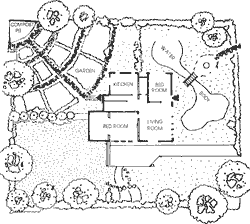Underlying Principles in Landscape Gardening
Landscape gardening is possible in large estates, big industrial houses and big public gardens. There are two main or major principles to be adhered to for effective landscaping. Bailey lays stress on these two leading concepts of landscaping. They are(1) To produce a 'picture in landscape'. According to this concept, the house forms the central figure of the picture which is surrounded by a canvas of lawns. The plantation gives the composition and colour to the landscape gardening.
(2) To produce natural or landscape effect. This is done by mass planting, as the mass has greater effect than individual planting, because it gives greater range and variety of forms, colours, shades and textures which are well blended. The much balanced and well blended combination of colour and form gives poetic and thought provoking ideas. The mind is not disturbed and distracted by irrelevant and incidental intervention of ideas. There are a few secondary concepts which should not be ignored. They serve as means and methods of making a picture:
- Though the garden may be formed of a number of homogenous parts but it should be developed in such a way that the observer gets the entire effect without stopping to analyse the parts. In short, it should appear one unity in diversity.
- To have one emphatic central focal point (as in a picture). This can be the house or villa.
- The central place is to be kept open. The sides of the garden should be filled with masses of plants.
- The garden should not appear with patches of scattered colours. The continuity is maintained by a continuous green background.
- The flowers should give a casual and incidental look in landscape. They are used to add emphasis and create colour and variety
- More emphasis is to be on the position of the plants with reference to one another and to the structural design, of the place than to the merits of an individual plant.
Laying out a garden:
Before commencing the planting operation, the owner or the gardener must have a clear picture and ideas of the garden. And for this he has to consider and keep in mind a few points:- Fixity of design: Before starting the gardener should decide the features he is going to have in his garden and considering these points come to the final design. The front of the house is occupied by a pleasure garden and the back the utility garden.
- Once the plan is ready, the first thing to do is to plant trees along the boundaries The fence is to be erected to protect the plants and for demarcating the entire area.

- The weeds are to be removed and the ground leveled. Planning should be according to the contour of the place. If the soil is sloping, it should be terraced and joined by steps or if on one side it is sloping a little, an artificial waterfall can be formed.
- Water-logged soil should be drained by cutting trenches. The carriageways and roads linking the different parts of the garden should be marked and formed of a firm material. They should not be straight in landscape gardening but having curves.
- Lawn is laid out in front of the house which w7ould lead to trees and shrubs.
- In front of masses of green trees, shrubs with colored flowers are planted and in front of the shrubs, colored annuals are planted.
- When lawns are large and long, a few big and stately trees are planted separately at different places. The planting on lawn should not be crowded. Along the sides herbaceous plants with colored flowers are planted.
- The garden should not end abruptly; The house should have potted plants in verandas, creepers and hanging baskets with plants.
The concept of home has changed in the modern world, and in landscaping the person would like to achieve some advantages, his individuality and entity. The goals are
(1) privacy,
(2) convenience and safety,
(3) comfort,
(4) ease of maintenance, and
(5) flexibility.